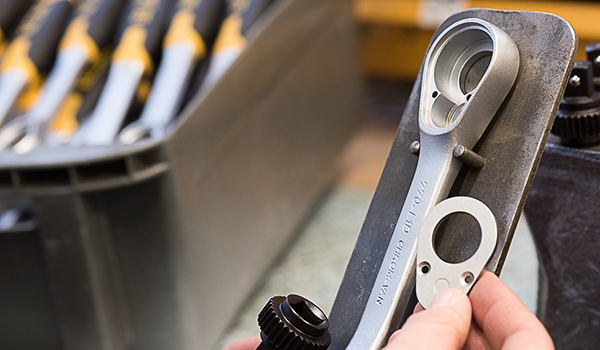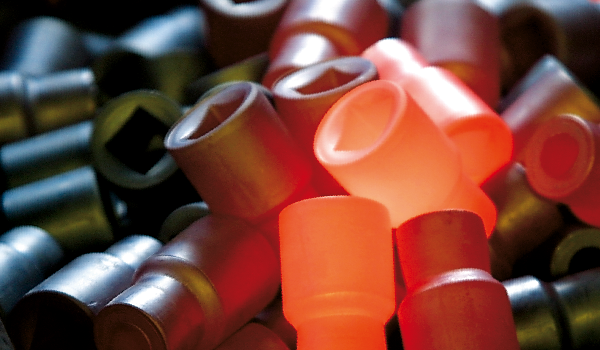Production
Stages in the production
of a spanner
Step by step to perfection
Our other product characteristics are equally impressive. Every ELORA spanner contains the collective skills, knowledge and experience of several generations of work in tool manufacture – a fact that is worth every cent and gives the end user the security that he or she has made a worthwhile investment in the future. This means you can look forward to highestgrade quality tools that will work perfectly for
years and look great at the same time.
Blanking
The starting material is high-grade ELORA chrome vanadium 31 CrV3/1.2208. The cropped blank for the spanner is cut from the rough blank. The characteristic shape is recognisable even at this early stage.

Hot forging & flash removal
The cropped blank is heated in a furnace to the correct forging temperature and then drop forged in this hot state using high press forces.

Hot forging & flash removal
Following this, the flash is then removed using flash-removal presses.

Hole punching
In the next step, the hole at the ring-end of the spanner is punched.

Grinding & vibro-deburring
The subsequent grinding process ensures the tool has a smooth outside surface. Any sharp edges and flash still remaining are then removed by vibro-deburring.

Ring and jaw broaching
The purpose of the broaching operation is to ensure the ring and jaw ends have exactly the right dimensions.

Profile punching
The individual marking that identifies our spanners around the world is added during the profile punching operation.

Hardening and tempering
This special heat treatment ensures our spanners enjoy the longest possible service lifetimes. The tool’s tensile strength is provided by precise hardening and the high level of ductility by the tempering process.

Sand blasting & head polishing
To make sure the spanner has a matt, non-slip surface, we sand-blast it. The jaw-end is then also polished to give it a smooth finish.

Chrome-plating
Finally, the spanner is nickel-plated and chrome-plated in an electroplating process. The final product now boasts effective surface protection and a specially high-grade appearance. Typically ELORA.

Further insights into the manufacturing process

Ratchet and drive

